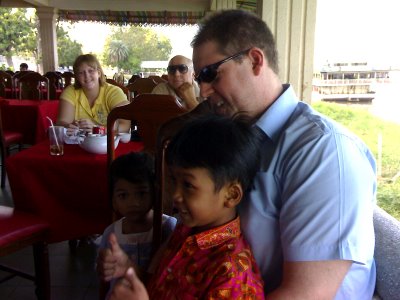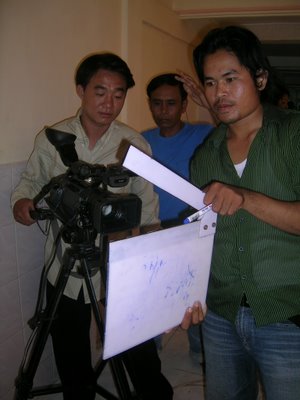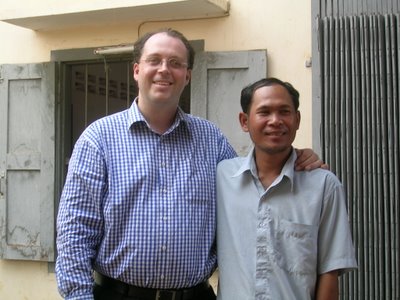 Ko Ko Ro Japanese Restaurant
Ko Ko Ro Japanese Restaurant
Sushi, Sashimi, Teriyaki, Sake, all the usual eats and treats Japan.18 Sihanouk Boulevard, Phnom Penh.
(Southside of the road, East of Norodom Boulevard, West of Sothearos Boulevard)
11:00 to 14:00; 17:30 to 21:00
Ph: 012 601 095 E:
yano_toshiyuki@hotmail.comAfter rather too many beers at DV8, followed by a fair number of happy hour ‘buy-one-get-one-free’ Bombay Sapphires and tonic at Bar 104, the intrepid group of Khmer440 gastronomes decided that the only food that would slake our rising hunger was raw fish – possibly a craving for mercury was the root cause of our desire?
After a brief conversation it became apparent that none of us knew much about the Japanese restaurants in Phnom Penh, or even Japanese cuisine in general, other than the facts it often involves raw fish and is usually expensive.
When one member of our group suggested a cheaper, not so flashy, Japanese restaurant that we had not been to before, the decision was made for us, hence our arrival at Ko Ko Ro on an otherwise ordinary Thursday evening.
Kokoro in Japanese means
feelings, or
heart, or
the heart of things. It is also the title of Natsume Soseki’s 1914, three part novel about guilt, ego and isolation, with a hint of betrayal and love served on the side, like wasabi to sashimi, only the novel ends with suicide not the bill and a tip. The book deals with the ending of Japans traditional ways and its modernisation, it does this by exploring a friendship between a young man and an older friend – referred to as sensei, or teacher.
I am not sure if an English language version of the book is available in Cambodia, I think I will see if I can find one, it has been a long time since I read it and I recall enjoying it.
Arriving at the Ko Ko Ro restaurant we found parking easy on Sihanouk Boulevard, once inside the décor reminded me of a small English transport café. Photos of the dishes on the walls, piles of magazines and papers scattered around, cheap tables and chairs, peeling paint work, in short, a place past its prime but just about holding itself together.
The owner and chef Toshi (heeeey, just call me Tony!) is quite a character, with his quick, chatty, English and bright red hair. After the meal he sat himself down at the table and regaled us merrily with the tale of his drunken driving charge while living in America – which resulted in a 6 month driving ban.
As well as him saying how much happier he was in Cambodia where everything was much more relaxed. In fact, the only point during the evening when he did not seem totally relaxed was when he started talking about the other Japanese restaurants in town that serve sushi, ‘they know nothing, they have never studied sushi, they do not import fish from Japan, most of them have Khmer sushi chefs who were trained by other Khmers who might have learnt from someone else, who learnt from a Japanese chef. He claims that he is the only
Itamae, skilled sushi chef, in Cambodia. grr, grr, grr.
- okay, the growl I added at the end of that, but you get the picture.
He added that he does not spend lots of money on decorating the restaurant, or fancy tables and chairs, or even advertising, so that he can keep his prices low. While the prices might still seem high when compared to a $1 plate of fried rice in a Khmer pavement café, they are considerably cheaper than the other Japanese restaurants in Phnom Penh.
Mixed sushi plate US$7A beginners (or slightly drunk lazy git) easy choice.
A collection of assorted rolls, maki, and several hand formed clumps of rice topped with different raw fish, nigiri, as well as a single egg nigirizushi. A small bowl of miso soup was served as well.
Mixed sashimi plate US$7Another beginners (or slightly drunk lazy git) easy delight.
Tuna, salmon and prawn in this mixed set along with the rice and miso soup. A small dish of pickled cucumber and radish slices,
Tuna maki-zushi US$3 -
two plates, the first was so goodLittle barrel rolls rice containing raw tuna at the centre, all tied together with a seaweed,
nori, bow. A tiny dip in the soy sauce – laced with
wasabi – and mmm, down they go.
Deep Fried Tofu in barbeque sauce US$2:50I know, I know, all I can say is that I did not order this, our token vegetarian did. Apparently it tasted very nice. Even if it did look like a pile of gooey custard in a brown slop, euk, where was the flesh of dead animals.
Teriyaki chicken US$3 or US$5I was slightly disappointed to see that we were in fact served tempura chicken not teriyaki chicken, although I am not sure if the mix up was; a problem with the menu, the Khmer waitress not understanding, or the fact that I was probably slurring the mixture of English, Khmer and Japanese I was using with the menu…
The tempura chicken however was remarkably good, bite size pieces of chicken breast coating in this traditional light and fluffy batter. It also came with a small dipping bowl of what seemed to be barbeque sauce (not teriyaki sauce as I first suspected that it might be). It was also the only dish that Heng would even taste, she point blank refused to even taste ‘
fish that not yet has been cooked’. Her considered opinion of the tempura chicken? ‘
okay, but I cook it better’ was her verdict; and who am I to disagree with a chef with such an international range as her.
Cans of Asahi US$1:25
>hic< just while we were perusing the menu, and then it was on to the sake. Thankfully all the changes at the brewery this year have not impacted on the flavour of Asahi; it is always cause for concern when a business gets a new CEO and a new COO in the same month, who knows what changes they could come up with to make the product cheaper.
Several bottle of hot sake US$7Served correctly in a tokkuri flask with shallow choko cups, this was a very, very, pleasant change from our day to day routine of cold beer and gins with tonic. The only thing that was incorrect was our ordering it in the first place, as traditionally sake is not drunk with sushi – although it may be drunk with sashimi. The belief being that one should not drink rice while eating rice, or some such inscrutable stuff.
This was only futsuu-shu – or normal sake – not tokutei meishoshu – designated special sake. But after a long abstinence of any sake it was welcome all the same.
AccoutrementsShoyu, dark Japanese soy sauce, a healthy amount of
wasabi, small dishes of pickled vegetable, et cetera.
In fact, I think it was the thought of
wasabi that swung me in the decision to dine Japanese this particular evening. That pungent and spicy green spice seemed to be calling me after a long week of mild Khmer dishes.
As is the norm for the majority of Japanese restaurants around the world, it was not true Wasabia japonicat, a member of the cabbage family which is grown in the shady mountainsides along the river valleys of Japan, such as the Izu peninsula, the cost of which is prohibitively high for all but the most expensive of restaurants to use, this wasabi was the usual imitation wasabi made from European horseradish, mustard and spirulina.
Besides the expense of real wasabi, it also loses it flavour as the fresh root dries out, which makes it difficult to serve properly.
Still, regardless of weather it was; real wasabi grated fresh from the root using an oroshigane, cultivated wasabi served from a toothpaste style tube, or imitation powdered wasabi, it was good. It was spicy and cleansing, stimulating the sinus cavity with its vapours – as opposed to chilli peppers which stimulate the tongues taste buds.
Even if we did commit another sushi
faux par by adding it to our soy sauce, rather than to the fish direct, this is the usual custom in Japan.
Azuki US$2
For dessert we had this popular Japanese dish, made from the adzuki bean, that has been boiled with sugar to create a red bean paste, served on top of a portion of vanilla ice cream; the fruity paste had a dry, almost tannic, after taste which was complimented very well by the sweet and slippery vanilla ice cream
After all this Toshi called for a round of complementary Japanese vodka, on the rocks – amusingly called Vodka Number One
Now I have to admit, the cost of it all is a little hazy to be honest, the sake was $7 a bottle, the Asahi $1:25, the total bill was around US$50, but I am not sure how much of that was booze and how much the food was.
Regardless, the food, not too mention the experience, was very enjoyable and I shall be returning soon, especially as Toshi has just taken delivery of some ‘oily tuna’ from Japan, which according to him is the very best cut of tuna that there is, although at US$60 a kilo I might only be ordering a small portion of it!
The next challenge for our intrepid team of raw fish eaters is to find a restaurant in Phnom Penh that serves either,
Ceviche – a Peruvian raw fish dish, or
Hoe – a Korean version of sashimi.
Domo arigato gozaimasta Toshi san. Gochisou-sama deshita.



































